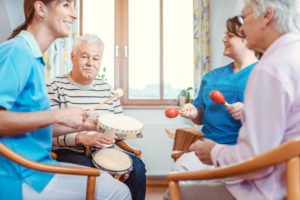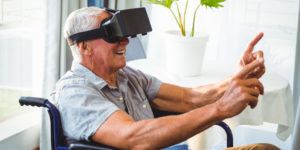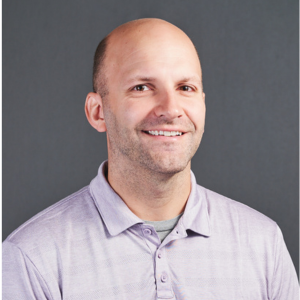Something to Sleep On— How to Improve Sleep for Residents with Dementia
When caring for residents with dementia, one quickly realizes that a common problem is sleep—too much or too little. If too little, not only is the resident not getting needed sleep, but the sleepless resident’s behaviors can disturb other residents. The vicious cycle of inadequate sleep impacts daytime events—residents are restless, irritable, agitated, and taking naps. As the lack of quality sleep accumulates, problems arise and residents take their frustrations out on each other or the staff.
Research shows sleep to be as important as food and water to long-term care residents’ well-being. In the State Operations Manual, Appendix PP (2017), CMS refers to quality of sleep over 30 times in multiple F-tags, such as those covering safe environment, dignity, comfort, home-like environment, and sound levels; adds emphasis on sleep quality to tags for behavioral health services and dementia care; and makes numerous references throughout to non-pharmacological interventions. These interventions add up to a sleep-hygiene program, which is defined by good sleep strategies.
Many residents’ sleep problems are related to intrinsic, extrinsic, institutional, and/or environmental factors; these factors can be minimized with culture-changing interventions.
Recall the sleep-wake cycle
A single cycle of sleep, consisting of four to five stages, lasts 90 to 110 minutes and repeats four to six times during the night. Sleep stages are divided into non-REM (Rapid Eye Movement) (stages one to four) and REM sleep (stage five). Stages one and two (lasting 5 to 15 minutes each) are called light sleep, as the individual drifts in and out of sleep several times and is easy to disturb and awaken. Stages three and four (5 to 15 minutes each) fall into the category of deep or “slow-wave” sleep. Stage five is called REM sleep.
For cognitively impaired residents, changes in sleep quality include increased nighttime awakening, more time in bed with less sleep, earlier sleep onset and awakening, increased time to fall asleep, decreased deep sleep, decreased REM sleep, and increased daytime napping. Additional comorbidities and/or medications lead to a formula for increased sensitivity to environmental distractions.
Utilize advances in care
Research and technology have introduced new information, tools, and solutions to reducing adverse events, increasing efficiency, and achieving positive resident outcomes. Using these, we can introduce effective, efficient, and safe sleep-hygiene programs.
For example, a turning and positioning study (Journal of American Geriatrics Society, October 2013) with 942 participants, aged 65 and older, with a Braden score of moderate to high risk for skin breakdown, and using high-density foam mattresses, found no difference in pressure ulcer incidence over three weeks among those turned at two-, three-, or four-hour intervals. Additionally, repositioning can be done using draw sheets for minimal disruption.
High-quality overnight incontinence products that wick moisture away and stay dry for six to eight hours can also reduce awakening. Other strategies to minimize nighttime toileting disruptions include encouraging residents to toilet as close to bedtime as possible and, for ambulatory residents, providing easy bathroom access by eliminating clutter and using nightlights.
Build mobility into daily routines
Residents who move more sleep better. Encouraging more movement encourages more restful sleep. Start with the following:
o Standing for a few extra seconds
o Walking a few additional steps
o Walking each day—if family members are capable and willing, encourage them, too, to get their loved one out for daily walks
o Decreased use of wheelchairs, instead adding seating for rest along hallways
o Seated exercise for non-ambulatory residents
o Fun with music and props
Choose the right bedtime snacks
Before bedtime, keep residents’ snacks light, and include “snooze food”: bananas, cherries, almonds, protein, milk, pineapple, peanut butter, chick peas, cheese and crackers, cereal and milk.
Be aware of pain
Residents with dementia often exhibit abnormal sleep patterns—daytime sleep and nighttime wakefulness. To improve sleep, consider unmet needs, especially pain. Sleep deprivation increases cortisol levels, increasing inflammation (pain). Sleep deprivation also increases anxiety levels. Pain increases when both sleep deprivation and anxiety are present. Consider using a pain assessment for advanced dementia, such as PAINAD (https://geriatricpain.org/assessment/cognitively-impaired/painad/pain-assessment-advanced-dementia-painad-tool). With the physician and pharmacist, review all medications and their impact on sleep and consider adjustments. Sleep medication is preferably avoided, due to the risk of poly-pharmacy. Try these ideas first:
o Maintain bright light during the day
o Encourage physical activity individualized for the resident’s tolerance
o Consider social and/or physical activities as tolerated
o Use music that matches the resident’s favorites
Provide sufficient daytime activity options
Keep residents actively engaged to expend energy and provide pleasure and movement. It takes a team! Staff members, including managers, should help provide activities that engage residents between 6 and 8 p.m. This delays early bedtime and fosters relationships with residents and families.
Reduce noise
Research shows that with less noise at night, there are fewer falls. The following can reduce sleep-disruptive noise:
o Eliminate personal alarms and overhead paging.
o Stop restocking supplies, cleaning the facility, and changing water pitchers at night.
o Delay shifts for housekeeping, activities, laundry, social services, and maintenance staff until 8:00 a.m. to prevent unnecessary noise: Only nursing and dietary staff should begin their shifts before 8:00 a.m. For residents who prefer to wake and eat early, consider continental breakfasts, which are easy to prepare and serve.
o Use big-screen TVs only if residents are awake and watching.
o Use small personal TVs with headsets in shared bedrooms.
o Answer call lights promptly.
o Remind staff to talk quietly, especially at shift change.
o Prohibit the night shift from gathering at the desk; require rounding.
o Pair light sleepers with very sound sleepers.
o Explore adjusting room placement to reduce noise.
Adjust lighting
At home, we turn off the lights at bedtime. The same should be done, within reason, at the skilled nursing facility.
o Use automatic timers and dimmers.
o Use white/blue spectrum at high-intensity levels for daytime (8 a.m.–8 p.m.).
o Use amber/red spectrum light, which gently lowers brain activity, at night.
o Use pathway motion-detector lights.
o For checks, use flashlights with amber lights or hug lights.
o Use toilet bowl lights.
o Consider motion-activated lighting under the bed.
Pay attention to the sleeping environment
Sleeping difficulties should raise questions about the mattress, pillows, and overall sleeping environment. Consider the following:
o Use static pressure-relieving redistribution or high-density foam mattresses.
o Provide correctly sized pillows for side or back sleepers as well as full body pillows. Keep the room dark, with the curtains pulled and door closed; ensure that the color of lights on clocks and radios is not distracting.
o Keep it cool—65–70 degrees Fahrenheit is usually ideal.
o Keep it quiet—or, if unable to, create white noise with a fan or provide ear plugs.
o Try aromas—lavender, vanilla, jasmine, or any preferred scent.
Conclusion
The goal of the sleep-hygiene program is uninterrupted sleep at night. It is time to fully realize the critical nature of quality sleep. Think about how you feel when your nighttime sleep is interrupted. Consider the disruptions in your facility when it is time for residents to sleep. Our residents deserve a quiet, restful night, and your team can make that happen. An improved daytime experience can be had by all. Sleep on it and get ready to take action!
I Advance Senior Care is the industry-leading source for practical, in-depth, business-building, and resident care information for owners, executives, administrators, and directors of nursing at assisted living communities, skilled nursing facilities, post-acute facilities, and continuing care retirement communities. The I Advance Senior Care editorial team and industry experts provide market analysis, strategic direction, policy commentary, clinical best-practices, business management, and technology breakthroughs.
I Advance Senior Care is part of the Institute for the Advancement of Senior Care and published by Plain-English Health Care.
Related Articles
Topics: Alzheimer's/Dementia , Articles











